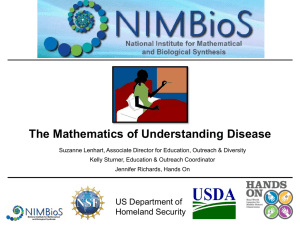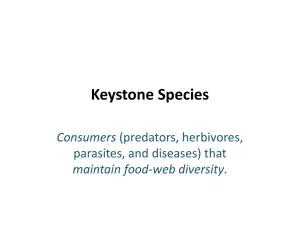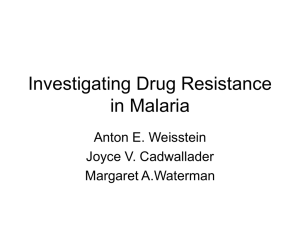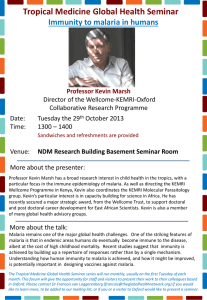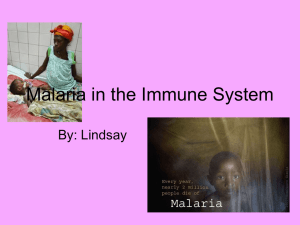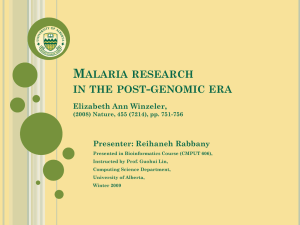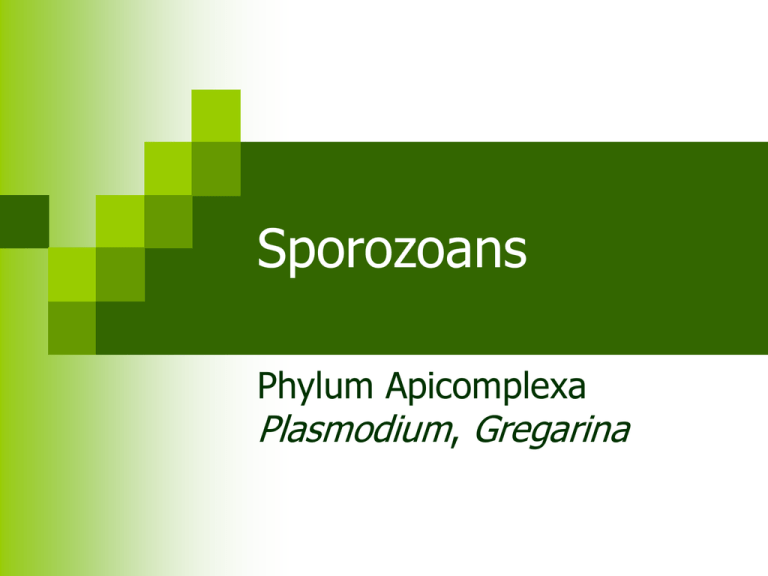
Sporozoans
Phylum Apicomplexa
Plasmodium, Gregarina
Apicomplexans
Heterotrophs: Parasites living in animal
cells
Cell-piercing
structure made of microtubules
Reproduce sexually and asexually in host cells
Only gametes have flagella
Example: Plasmodium (malaria)
Phylum Apicomplexa (Sporozoa)
No obvious means of locomotion
Some
have flagellated gametes
Class Sporozoea (Sporozoans)
All
are obligate parasites of animals
Gregarina in mealworms
Plasmodium causes malaria
Complicated life histories involving many hosts
Most form oocysts
Produce sporozoites following sexual reproduction
All life stages are haploid except for 2N zygote
Apicomplexa
Named for the apical
complex
Aids
cells
in penetration of host
Covered by pellicle and
two plasma membranes
Plasmodium
Apicomplexa
Cause parasitic disease in humans
(Plasmodium)
Coccidian diseases including:
Cryptosporidiosis (Cryptosporidium parvum)
Cyclosporiasis (Cyclospora cayetanensis)
Isosporiasis (Isospora belli)
Malaria
Toxoplasmosis (Toxoplasma gondii)
Diseases in livestock cause large scale economic
losses
Eimeria,
Babesia, Theileria
Apicomplexa
Outer covering
Thick,
triple outer layer which is very flexible, but
nearly impervious to biological, and even to most
chemical, agents.
First is the plasma membrane
Next is inner, double membrane made up of
flattened alveoli sutured together.
Finally, the whole business is reinforced with the
cellular equivalent of rebar -- longitudinal bundles
of microtubules running from the apical complex
back towards the posterior end of the cell. These
are cross-linked in some fashion.
Apical Complex
Set of secretory and cytoskeletal structures that
enables the young parasite to enter a host cell.
Several components
Two
apical or polar rings
A conoid - an open cone of spiral rod-like elements
Polar ring of dense granular material that connects
the ends of the longitudinal cytoskeletal microtubules
Rhoptries and micronemes; these are modified
secretory vesicles.
Possess apicoplast (plastid)
Apicoplast
Organelle derived from endosymbiosis in which
the apicomplexan ancestor engulfed a unicellular
alga.
Contains its own genome, a circular molecule of
DNA which encodes
~
30 proteins
a full set of tRNAs plus some other RNAs
Sequencing of apicoplast DNA shows it is closely
related to chloroplasts (Chlamydomonas)
Potential drug target – kill malaria with
herbicides!
Apicomplexa
Apical Complex
Rhoptries
(rhoptry = sing.) and micronemes
Special secretory organelles of the apical complex
that produce a large number of proteins
Protein functions:
Part of the machinery that is used by these
parasites both for invasion and to commandeer
host functions.
Modulate key regulators of the immune
response of the host.
Responsible for motility, adhesion to host cells,
invasion of host cells and establishment of the
parasitophorous vacuole inside the host cell.
Plasmodium (Malaria)
Plasmodium species cause malaria
Malaria
Malaria is a mosquito-borne disease caused by
several members of the genus Plasmodium.
People
with malaria often experience fever, chills, and
flu-like illness.
Left
untreated, they may develop severe
complications and die.
Each
year 350-500 million cases of malaria occur
worldwide, and over one million people die, most of
them young children in Africa south of the Sahara.
Mosquito = vector - transmits the
malaria parasite Plasmodium
vivax (a sporozoan)
Malaria parasite in
red blood cells
Parasites breaking
out of red blood cells
Malaria
Humans infected with malaria parasites can develop a
wide range of symptoms. These vary from
asymptomatic infections (no apparent illness),
to the classic symptoms of malaria (fever, chills,
sweating, headaches, muscle pains),
to severe complications (cerebral malaria, anemia,
kidney failure) that can result in death.
The severity of the symptoms depends on several factors,
species of infecting Plasmodium
human's genetic background
any acquired immunity to the parasite.
Malaria
This sometimes fatal disease can be prevented
and cured.
Bednets,
insecticides, and antimalarial drugs are
effective tools to fight malaria in areas where it is
transmitted.
Travelers
to a malaria-risk area should avoid mosquito
bites and take a preventive antimalarial drug such as
chloroquine.
Malaria
Antimalarial drugs taken for prophylaxis by
travelers can delay the appearance of malaria
symptoms by weeks or months, long after the
traveler has left the malaria-endemic area.
can happen particularly with P. vivax and P.
ovale, both of which can produce dormant liver stage
parasites.
Liver stages may reactivate and cause disease
months after the infective mosquito bite.
This
Anopheles mosquito
vector
Malaria
The incubation period in most cases varies from 7 to 30 days.
The shorter periods are observed most frequently with P.
falciparum and the longer ones with P. malariae.
The classical (but rarely observed) malaria attack lasts 6-10
hours. It consists of:
a cold stage (sensation of cold, shivering)
a hot stage (fever, headaches, vomiting; seizures in young
children)
and finally a sweating stage (sweats, return to normal
temperature, tiredness)
Classically (but infrequently observed) the attacks occur
every second day with (P. falciparum, P. vivax, and P.
ovale) and every third day with (P. malariae).
Malaria
Each attack starts with shaking chills, usually at mid-day
between 11 a.m. to 12 noon, and this lasts from 15 minutes
to 1 hour (the cold stage), followed by high grade fever,
even reaching above 41oC, which lasts 2 to 6 hours (the hot
stage).
The cycle corresponds to the toxins released during
rupture of the schizont-infected red cells and release of
large numbers of merozoites.
These toxins reset the hypothalamus gland’s temperature
set point – chills help raise body temp to this new point.
The hot stage is followed by profuse sweating and the fever
gradually subsides over 2-4 hours.
Toxoplasmosis
Toxoplasma gondii
Kinetoplastida
Toxoplasmosis
Parasite causes eye and brain damage in a baby,
if untreated.
Acute infection in older children and adults may
be without symptoms, cause flu like illness or
enlarged lymph glands.
Latent parasite occurs very commonly in people
infecting approximately a third to a half of all
humans.
Can
cause active disease if a person becomes
immune compromised
Brain damage and death
Toxoplasma gondii
Clinical Features:
Generally an asymptomatic or mild self-limiting
infection.
Immunodeficient patients
Brain lesions, death
Pneumonitis
Pregnant women/infant
Miscarriage; still births
Cerebral palsey; seisures
Mental retardation
Eye infections; impaired
vision
Enlarged liver and spleen
Gregarines
Apicomplexan (Sporozoan)
parasites of insects.
Recall observations of these
parasites in intestine of meal-worm
larvae (Tenebrio molitor beetles).
Gregarina polymorpha
Gregarines
Host consumes a sporozoite or sporocyst containing them
Sporozoite attaches to host intestinal epithelium with
structure called epimerite
Transforms into feeding stage called trophozoite
Sexual stage begins when two trophozoites (gamonts) of
opposite sex associate in syzyge
Produces a walled gametocyst which is expelled with the
feces.
Within cyst the two gamonts divide to form many gametes
which fertilize within the cyst to form a zygote called a
sporocyst which undergo meiosis to form 1n sporozoites
Gregarina oosysts
Gregarina in syzyge
Cryptosporidium
Causes Cryptosporidiosis
Obligate intracellular parasite
Causes diarrhea
Affects humans, cattle, sheep, dogs
No effective drug treatment for cryptosporidiosis
Antibiotics are contraindicated; supportive care
only
Cryptosporidium
Major outbreaks in Milwaukee in 1993 and
1996
Cause
was failure in one of the water
treatment pumping stations
Sewage
No
backed up into drinking water
required testing for Crypto under EPA stds.
Major
cities now test for Crypto regularly
Cryptosporidium affects
humans, dogs, and cattle
Cryptosporidium can be a
problem in municipal water
supplies.
Ciliates
Subphylum Ciliophora
Functional groupings of ciliates
Holotrich- uniform ciliation
Heterotrich- possess membranes &/or cirri
Peritrich- cilia only around the cytostome
Colonial-living in colonies
Suctorian- a clade of Ciliophora possessing
hollow feeding tentacles
An assortment of freshwater ciliates- biodiversity!
This figure shows 167 species- about 9500 species are known
Ciliophora (ciliates)
A major clade within the Alveolates.
Synapomorphies of ciliates include:
Ciliated
pellicle and associated kinetodesmata
Dimorphic nuclei
conjugation
Primarily holotrophic- few parasitic.
Many can form cyst stage (resting stage).
Ciliates
Paramecium
Paramecium bursaria
Stentor coeruleus
Vorticella
Stylonychia
Cirri
ciliary organelles used for food handling and
locomotion- form membranes or bundles
Ciliophora
Euplotes
a heterotrich
ciliate showing
complex cirri
used for feeding
and locomotion
Euplotes
Spirostomum
Didinium
http://www.uga.edu/protozoa/portal/images/movies/didinium.mov
Balantidiasis
Most cases are asymptomatic.
Clinical
manifestations, when present, include
persistent diarrhea, occasionally dysentery, abdominal
pain, and weight loss.
Symptoms can be severe in debilitated persons.
Diagnosis is based on detection of trophozoites
in stool specimens or in tissue collected during
endoscopy.
Repeated
stool samples necessary to find
trophozoites
Treatment: Tetracycline with metronidazole
and iodoquinol as alternatives
Trophozoites
Cyst
B. coli trophozoites
Ciliophora
Ichthiopthirius multifilis (Ich)
• Common parasite of
freshwater and marine
fishes
• Trophozoite burrows in
skin
• Mature troph leaves fish
and encysts.
• Multiple mitoses produce
hundreds of “swarmers”
that reinfest fish.
Ich trophozoite in fin of
freshwater drum
M. C. Barnhart
Diversity of protists use
pseudopodia for movement
Most are heterotrophs and use pseudopods to
hunt for food
Unsure of their place in a phylogenetic tree
So
we won’t worry about trying to get the newest
phylogeny here
See organization on the phylogenetic tree in this slide
set
Ameobozoa (like Chaos and Arcella)
and some in the Chromista (heliozoans like
Actinosphaeria)
Rhizaria
Radiolaria and Foraminifera
Rhizaria
Have thin, hairlike extensions of the
cytoplasm called filose pseudopodia
Chlorarachniophyta
Radiolaria and Foraminifera
Ocean
plankton that make mineral shells
White cliffs of Dover, England
Foraminifera used to infer past climates
Rhizaria
Single-celled
heterotrophs with a secreted
shell
Many openings for pseudopods
Actinopoda (heliozoans
and radiolarians)
Actinopod means “ray
foot”
Extensions
of slender
pseudopods
Radiolarians
Heliozoans –
Fresh
water habitat
Skeletons consist of
silica
Radiolaria
siliceous tests
Axopodia with axonemes
Test - Note pores
Foraminifera (forams)
Forams are all marine
Named for their
porous shells
Hardened with
calcium carbonate
Chalk
White
Cliffs of Dover
Foraminifera
Fig. 25-20b, p. 549
Amoebozoa
All unicellular
Amoeba proteus
Amoebae
Actinosphaerium
Chaos
Arcella
Amoebae
Difflugia
Arcella
Amoebozoa
Pseudopodia
feeding
locomotion
a few also have flagella
Anatomy
simpler
than other protozoa
fewer organelles
no pellicle
may have test (shell)
“testate” amoebae
secreted or made of debris
Free-living, symbionts, parasites
Amoebozoa
Classification
Based
on type of pseudopodia
Lobopodia: broad, rounded lobes
Filopodia: thin, no endoplasm, (branched)
Reticulopodia: thin, branched, netlike
Actinopodia: long, straight, thin, core of
microtubules
See page 73 and
http://www.biani.unige.ch/msg/Amoeboids/Amoebozoa.html
Mycetozoa (Slime Molds)
Mycetozoa “fungus
animals”
They decompose leaf
litter like fungi
But
they are not fungi
Use pseudopodia for
movement
Two distinct groups
Plasmodial
slime mold
Cellular slime mold
Myxogastridia (Plasmodial Slime
Mold)
Most are brightly colored
All are heterotrophic
Life cycle contains:
Feeding
stage (mobile)
Large mass of unicellular organisms that is not
separate by cell walls
Fruiting
body (not mobile)
Plasmodial Slime Mold
Dictyostelida: Cellular Slime
Mold
Feeding stage consists of individual cells
When
food is scarce form an aggregate that
functions as a unit
Cellular Slime Mold
Infective Amoebas: Entamoeba
Amoebiasis caused by
Fourth most common
protozoan infection in the
world
Aka amoebic dysentery
Entamoeba histolytica
Entamoeba histolytica
Figure 5.28
Entameoba histolytica
Causes amoebic
dysentery (diarrhea) and
can enter the liver, lungs,
and brain
Cysts
Entameoba histolytica
Clinical Features:
A
wide spectrum
from asymptomatic infection ("luminal amebiasis"),
to invasive intestinal amebiasis (dysentery, colitis,
appendicitis, toxic megacolon, amebomas),
to invasive extraintestinal amebiasis (liver abscess,
peritonitis, pleuropulmonary abscess, cutaneous
and genital amebic lesions).
Up to 100K deaths/yr worldwide, second only to
malaria and schistosomiasis
Naegleria fowleri
Naegleria fowleri
Clinical Features:
Acute primary amebic meningoencephalitis (PAM) is
caused by Naegleria fowleri.
It presents with severe headache and other
meningeal signs, fever, vomiting, and focal neurologic
deficits, and progresses rapidly (<10 days) and
frequently to coma and death.
Acanthamoeba spp. causes mostly subacute or
chronic granulomatous amebic encephalitis (GAE),
with a clinical picture of headaches, altered mental
status, and focal neurologic deficit, which progresses
over several weeks to death.
Acanthamoeba
addition, Acanthamoeba spp. can cause
granulomatous skin lesions and, more seriously,
keratitis and corneal ulcers following corneal trauma
or in association with contact lens use. Non-contact
lens users and contact lens users with safe lens care
practices can become infected. However, poor
contact lens hygiene and exposure to contaminated
water may increase the risk among contact lens
users.
In
Opisthokonts
Animals and their kin
Opisthokonts
One group of flagellates, the
choanoflagellates, is thought to
have given rise to the simplest
animals, the sponges.
Choanoflagellida
Sponge Choanocytes
Amoebocytes in the mesohyl

